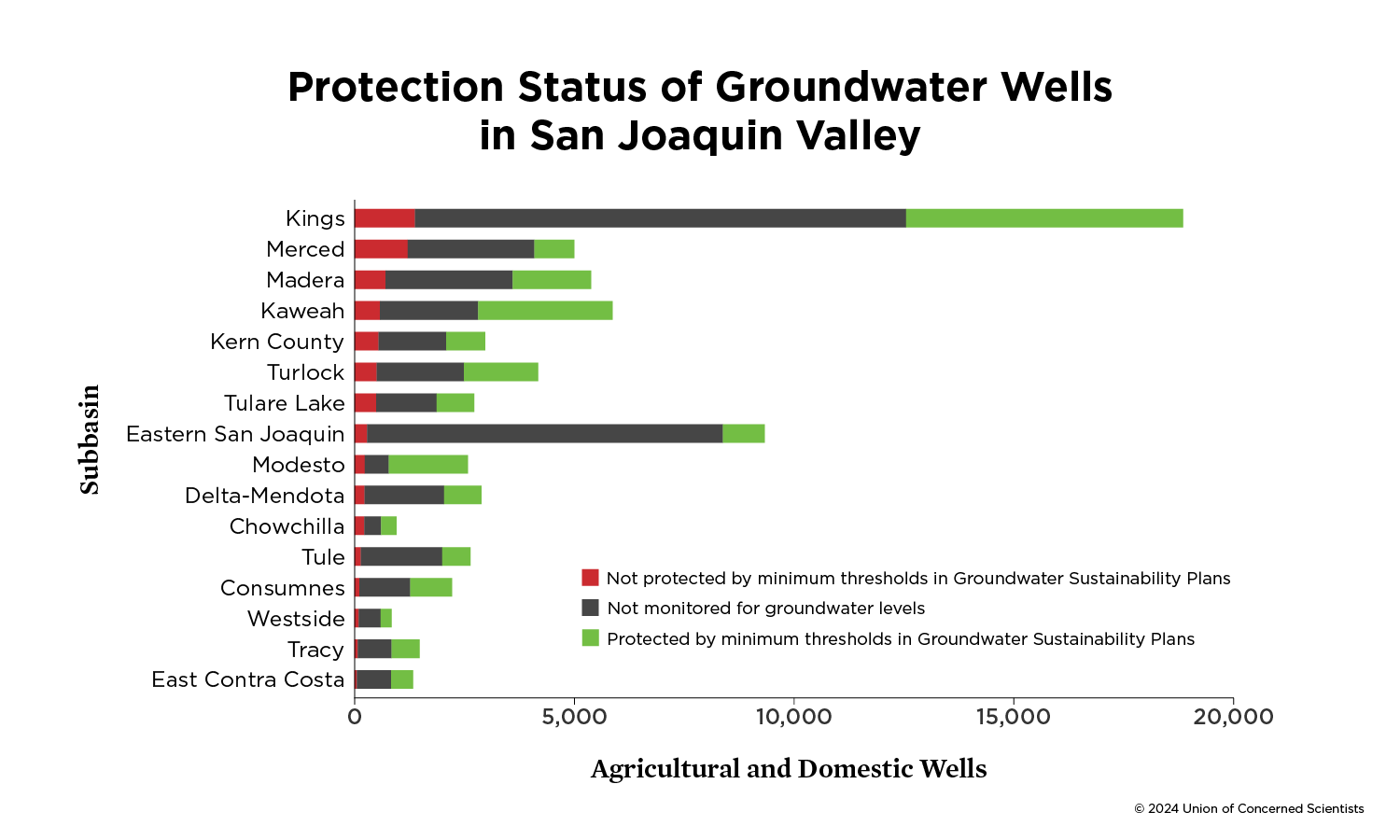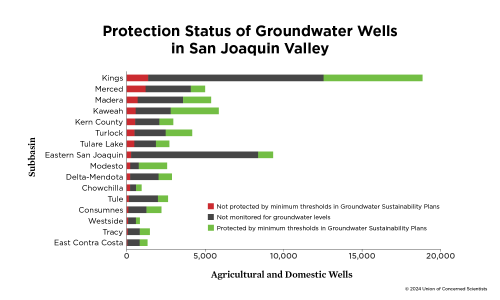Understanding the future of groundwater sustainability is crucial for low-income and farmworker communities, and their local and state representatives
The negative impacts of falling groundwater levels drove California to adopt the historic Sustainable Groundwater Management Act, which requires consideration of climate change impacts when developing local Groundwater Sustainability Plans (GSPs). Yet, many GSPs do not include readily accessible climate data in ways that actually protect communities.
This fact sheet describes how to responsibly include climate information in groundwater planning efforts to better understand the implications for low-income and farmworker communities.
Understanding Future Groundwater Sustainability Scenarios from a Community Perspective
Groundwater overpumping has threatened the living conditions and the physical and mental health of low-income and farmworker communities in California for decades (Brown, Flores, and Padilla 2023). Understanding the future of groundwater sustainability, including sustainability in diverse climate change scenarios, is crucial for these communities and their local and state representatives. The negative impacts of falling groundwater levels drove California to adopt the historic Sustainable Groundwater Management Act, which requires consideration of climate change impacts when developing local Groundwater Sustainability Plans (GSPs). Yet, many GSPs do not include readily accessible climate data in ways that actually protect communities. This fact sheet describes how to responsibly include climate information in groundwater planning efforts to better understand the implications for low-income and farmworker communities.
It Is Dry and Getting Drier
Conditions of the driest period in the western United States in the last 1,200 years have a one-in-two chance of repeating within the next 75 years—or it could be even drier.
The megadrought in the western United States continues to add pressure to water resources, as it has since 2000. It will go on until 2030 in 75 percent of simulated climate futures (Williams, Cook, and Smerdon 2022). Also alarming is the increased probability of extreme droughts like these. Even under conservative warming scenarios, a 21-year drought equal to or more severe than the 2000-2021 drought has a 50 percent likelihood of occurring by the end of the century (Williams, Cook, and Smerdon 2022). In other words, conditions of the driest period in the western United States in the last 1,200 years have a one-in-two chance of repeating within 75 years—or it could be even drier.
Within the current megadrought, some periods have hit California low-income communities and farmers harder. Most recently, these include the droughts from 2012 to 2016 and from 2019 to 2022; both ended with record precipitation events that brought extreme flooding. These droughts led to degraded water quality(Smith, Knight, and Fendorf 2018), land subsidence (Levy et al. 2020), reduced storage (Massoud et al. 2018) and storage capacity (Ojha et al. 2018), surface water depletion (Saito et al. 2021), and unprecedented declines in groundwater levels (Pauloo et al. 2020). For rural, underserved communities, the droughts manifested as higher water and food prices, increased property crime, increased unemployment, lower wages, wells that run dry (leaving families without access to safe and reliable water for cooking, drinking, and sanitation), and worse air quality (Goin, Rudolph, and Ahern 2017; Zeighami et al. 2023).
While other regions of the western United States are also going through dry conditions, no area has seen impacts as inequitable as the San Joaquin Valley, where large agricultural corporations are depleting the water of low-income and farmworker communities and small family farmers:
-
Since 2013, more than 4,300 wells in the San Joaquin Valley have gone dry or failed (California Department of Water Resources 2024).
-
At least 7,000 wells are at risk of drying under the current limits set by Groundwater Sustainability Agencies (GSAs; minimum thresholds) (Perrone et al. 2023; Bostic et al. 2023). This number is likely larger, but not enough monitoring wells exist to assess impacts on every well (Figure 1).
-
Over 40,000 agriculture and domestic wells—more than half of the wells in the San Joaquin Valley—do not have monitoring wells nearby that may serve as an early warning system for dropping groundwater levels (Perrone et al. 2023).
-
As regulations around the Sustainable Groundwater Management Act develop, corporate consolidation of farmland and the number of deeper wells grow. The corporations buy out smaller farms (Rempel et al. 2024), and their actions raise questions about why drilling deeper is appropriate if the overall objective is stable groundwater levels.
-
Rural farmworker communities are dealing with well failure, affected by key factors such as the presence of perennial crops, socioeconomic conditions, well density (both domestic and agricultural), and well depth (Rodriguez-Flores et al. 2023).
-
Over the past decade, only in the San Joaquin Valley have rising temperatures led to a 4.4 percent annual increase in crop water needs (evapotranspiration), representing almost 650,000 acre-feet of extra water demand per year (Moyers et al. 2024). Evapotranspiration is projected to further increase 13--18 percent within the next 75 years (McEvoy et al. 2020).

As California continues its path into an arid future, it is important to recognize that today's dire situation is not a result of climate change alone, but that climate change exacerbates the long history of industrial agribusinesses exploiting people, soils, and water in the valley. And as the situation is mostly human caused, the state has the opportunity and responsibility to remediate the harm done to low-income and farmworker communities using equitable policy solutions. In addition, every action taken to reduce heat-trapping gas emissions, especially a fast and fair phaseout of fossil fuels, will contribute to mitigating the impacts of climate change and reducing the vulnerability of communities and ecosystems.
Improve Climate Change Planning to Protect Communities from Droughts and Floods
The California Department of Water Resources must revise and provide tools to update projected water budgets presented in GSPs to reflect accurate projections of water availability and demand.
Concerns arise regarding the approach to comprehensive climate change planning in GSPs, which the Department of Water Resources' climate change guidance may have influenced. The department's document titled Guidance for Climate Change Data Use during Groundwater Sustainability Plan Development recommended GSAs use so-called 2030 and 2070 central tendency scenarios, though the document does "encourage" planning for more stressful future conditions. This recommendation could lead to large-scale underestimations of climate change impacts. The central tendency scenario, representing an average of various climate projections, is not necessarily the most likely, and it will always underestimate more severe future climate conditions.
The benefits of achieving sustainability significantly outweigh the investments made toward sustainable practices. Updated GSPs must include enough climate change analysis to address extreme climate change scenarios and describe planning and management actions to reach sustainability accordingly.
Overdraft projections must be realistic and accurate. GSAs must reconsider the "glide path" approach—a strategy to decrease water extraction slowly over time, to avoid sudden shortages in agriculture—as it contributes to the ongoing decline of groundwater levels, leads to wells going dry, and causes water shortages for people. This approach, intended to ease the transition toward sustainable water use, may not sufficiently counteract the rate at which groundwater is being depleted, especially when combined with other stressors, such as increased water demand and prolonged drought conditions.
Some estimates suggest the groundwater overdraft in the San Joaquin Valley is 1.85 million acre-feet, since that was the average from 1988 to 2017. However, groundwater overdraft has increased dramatically in recent years. In the second half of that period (2003--2017), it totaled 2.4 million acre-feet (Hanak et al. 2019). In 2021, groundwater overdraft in the San Joaquin Valley amounted to 5.4 million acre-feet, and the average from 2019 to 2022 was 3.1 million acre-feet. While some of these were drought years, they served as an example of California's thirsty future, for which the state and local water agencies need to plan. Given climate projections, groundwater overdraft will likely continue increasing unless immediate and effective measures are taken (Massoud et al. 2018).
GSAs must plan for extreme climate scenarios that represent the reality of future California and lead to appropriate projects and management actions.
In 2022, a coalition of environmental justice and conservation organizations evaluated 31 GSPs from critically overdraft basins. They found that 28 of the 31 GSPs reviewed did not adequately incorporate extreme climate scenarios, despite having access to 2070 projections for both dry and extreme warming, and wetter with moderate warming futures (Arthur et al. 2022). As a result, most GSAs risk not developing projects and management actions to ensure sustainability under realistic climate conditions, which will very frequently diverge from the central tendency scenario.
GSAs handle the sustainable management of local groundwater resources. Fundamental to water management is the development of accurate water budgets, which are estimates of historical, current, and projected water inputs (like precipitation), outputs (evaporation and transpiration from crops), and storage changes (groundwater levels). This information helps predict water use and availability, ensuring that management actions lead to sustainable water use. While GSPs incorporate climate change in their projected water budgets, most could be overestimating water availability and underestimating water demands.
For example, while GSAs are all planning for a hotter future that ramps up water demands, most plans in the San Joaquin Valley show higher future water availability due to slight increases in projected precipitation. Not all climate scenarios project such a future. Other climate projections show declines in precipitation and multiyear droughts equal to or greater than the 2012--2016 and 2019--2022 droughts (Williams, Cook, and Smerdon 2022). Planning explicitly for a drier future scenario is essential to consider climate change adequately, enhance sustainability, and boost community resilience.
Strengthening existing and future land repurposing efforts to better invest in low-income and farmworker communities can bring water sustainability and reduce climate vulnerability.
To reach groundwater sustainability, California will need to retire about 1 million acres of irrigated cropland, most of it in the San Joaquin Valley (Hanak et al. 2023). This change is so significant that it requires a transition plan to repurpose some cropland into other land uses. Otherwise, if this massive change is left to market forces, small and medium-sized farmers, farmers who are people of color, and low-income and farmworker communities will likely experience a disproportionately negative effect.
However, if cropland repurposing is done adequately, following best practices and being informed by interested local parties and community partners, the challenge can become an opportunity to improve the living conditions and health of millions of Californians who live with the negative externalities of some conventional agriculture practices (for example, asthma triggered by pesticide applications and dust from tillage and almond harvesting). Climate-informed planning can guide the selection of new crops, land uses, and practices that are resilient to future climate conditions. Best cropland repurposing practices also include environmental and health protections while providing new socioeconomic and development opportunities to diversify local economies without losing the local agricultural identity (Fernandez-Bou et al. 2023).
The state has launched the Multibenefit Land Repurposing Program to convert land impacted by water availability to sustainable uses. The program has already received $90 million in funding and will benefit multiple users. It requires the provision of meaningful benefits to disadvantaged communities. Implementing safeguards is crucial to ensure the program's success. These safeguards should ensure that the investments directly assist those hardest hit by unsustainable and inequitable groundwater practices. Furthermore, they should guarantee that the funded projects and infrastructure are resilient against future climate threats, thereby promoting long-term sustainability.
A key component of these safeguards would be a clear definition of meaningful benefits and the enforcement of Community Benefits Agreements. These agreements, vital for ensuring that multibenefit cropland repurposing projects adhere to community benefit plans, will be binding commitments that detail how the project will positively impact a disadvantaged community and guarantee critical investments.
Sustainable Groundwater Planning Is Equitable Groundwater Planning
The journey toward sustainable groundwater management represents an opportunity to correct the wrongs of past water management practices. The risk is high, with low-income and farmworker communities bearing the worst of water scarcity. The call to action is clear: state and local water agencies must develop project and management actions that will lead to groundwater sustainability under extreme climate conditions, ensuring that solutions are effective and equitable.
J. Pablo Ortiz-Partida is the director of collaboration and innovation.
Acknowledgments
This analysis was made possible by the generous support of the Water Foundation, Environment Now, and UCS members.
For their thoughtful review and comments, the author thanks Kyle Jones, Justine Massey, and Kjia Rivers from Community Water Center; Nataly Escobedo Garcia from Leadership Counsel for Justice and Accountability; Jennifer Clary from Clean Water Action; Angela Islas from Central California Environmental Justice Network; and Juliet Christian-Smith and Angel S. Fernández-Bou from the Union of Concerned Scientists.
Organizational affiliations are listed for identification purposes only. The opinions expressed herein do not necessarily reflect those of the organizations that funded the work or the individuals who reviewed it. The Union of Concerned Scientists bears sole responsibility for the report's contents.
References
Arthur, Samantha, Ngodoo Atume, J. Pablo Ortiz-Partida, and Melissa M. Rohde. 2022. Groundwater Sustainability Assessments: A review of the Department of Water Resources' determinations on groundwater sustainability plans in critically overdrafted basins. Sebastopol, CA: Groundwater Leadership Forum. https://groundwaterexchange.org/wp-content/uploads/2022/08/NGO-DWR-Determinations-Analysis-2022.pdf.
Bostic, Darcy, Linda Mendez-Barrientos, Rich Pauloo, Kristin Dobbin, and Victoria MacClements. 2023. "Thousands of Domestic and Public Supply Wells Face Failure despite Groundwater Sustainability Reform in California's Central Valley." Scientific Reports 13: 14797. https://doi.org/10.1038/s41598-023-41379-9.
Brown, Paul, Edward Flores, and Ana Padilla. 2023. Farmworker Health in California. Merced: University of California, Merced. https://clc.ucmerced.edu/sites/clc.ucmerced.edu/files/page/documents/fwhs_report_2.2.2383.pdf.
California Department of Water Resources. 2024. "Statewide Summary." Accessed April 2, 2024. https://mydrywatersupply.water.ca.gov/report/publicpage.
Fernandez-Bou, Angel Santiago, José M. Rodríguez-Flores, Alexander Guzman, J. Pablo Ortiz-Partida, Leticia M. Classen-Rodriguez, Pedro A. Sánchez-Pérez, Jorge Valero-Fandiño, et al. 2023. "Water, Environment, and Socioeconomic Justice in California: A Multi-benefit Cropland Repurposing Framework." Science of the Total Environment 858 (3): 159963. https://doi.org/10.1016/j.scitotenv.2022.159963.
Goin, Dana E., Kara E. Rudolph, and Jennifer Ahern. 2017. "Impact of Drought on Crime in California: A Synthetic Control Approach." PLOS ONE 12 (10): e0185629. https://doi.org/10.1371/journal.pone.0185629.
Hanak, Ellen, Alvar Escriva-Bou, Brian Gray, Sarge Green, Thomas Harter, Jelena Jezdimirovic, Jay Lund, Josué Medellín-Azuara, Peter Moyle, and Nathaniel Seavy. 2019. Water and the Future of the San Joaquin Valley. San Francisco, CA: Public Policy Institute of California. https://www.ppic.org/wp-content/uploads/water-and-the-future-of-the-san-joaquin-valley-february-2019.pdf.
Hanak, Ellen, Andrew Ayres, Caitlin Peterson, Alvar Escriva-Bou, Spencer Cole, and Zaira Joaquín. 2023. Managing Water and Farmland Transitions in the San Joaquin Valley. San Francisco, CA: Public Policy Institute of California. https://www.ppic.org/publication/managing-water-and-farmland-transitions-in-the-san-joaquin-valley/.
Levy, Morgan C., Wesley R. Neely, Adrian A. Borsa, and Jennifer A. Burney. 2020. "Fine-Scale Spatiotemporal Variation in Subsidence across California's San Joaquin Valley Explained by Groundwater Demand." Environmental Research Letters 15 (10): 104083. https://doi.org/10.1088/1748-9326/abb55c.
Massoud, Elias C., Adam J. Purdy, Michelle E. Miro, and James S. Famiglietti. 2018. "Projecting Groundwater Storage Changes in California's Central Valley." Scientific Reports 8: 12917. https://doi.org/10.1038/s41598-018-31210-1.
McEvoy, Daniel J., David W. Pierce, Julie F. Kalansky, Daniel R. Cayan, and John T. Abatzoglou. 2020. "Projected Changes in Reference Evapotranspiration in California and Nevada: Implications for Drought and Wildland Fire Danger." Earth's Future 8 (11): e2020EF001736. https://doi.org/10.1029/2020EF001736.
Moyers, Kelley, John T. Abatzoglou, Alvar Escriva-Bou, Josué Medellín-Azuara, and Joshua H. Viers. 2024. "An Invisible Water Surcharge: Climate Warming Increases Crop Water Demand in the San Joaquin Valley's Groundwater-Dependent Irrigated Agriculture." PLOS Water 3 (3): e0000184. https://doi.org/10.1371/journal.pwat.0000184.
Ojha, Chandrakanta, Manoochehr Shirzaei, Susanna Werth, Donald F. Argus, and Tom G. Farr. 2018. "Sustained Groundwater Loss in California's Central Valley Exacerbated by Intense Drought Periods." Water Resources Research 54 (7): 4449--60. https://doi.org/10.1029/2017WR022250.
Pauloo, R. A., A. Escriva-Bou, H. Dahlke, A. Fencl, H. Guillon, and G. E. Fogg. 2020. "Domestic Well Vulnerability to Drought Duration and Unsustainable Groundwater Management in California's Central Valley." Environmental Research Letters 15 (4): 044010. https://doi.org/10.1088/1748-9326/ab6f10.
Perrone, Debra, Melissa M. Rohde, Courtney Hammond Wagner, Rebecca Anderson, Samantha Arthur, Ngodoo Atume, Meagan Brown, et al. 2023. "Stakeholder Integration Predicts Better Outcomes from Groundwater Sustainability Policy." Nature Communications 14: 3793. https://doi.org/10.1038/s41467-023-39363-y.
Rempel, Jenny Linder, Ella Belfer, Isha Ray, and Rachel Morello-Frosch. 2024. "Access for Sale? Overlying Rights, Land Transactions, and Groundwater in California." Environmental Research Letters 19: 024017. https://doi.org/10.1088/1748-9326/ad0f71.
Rodriguez-Flores, Jose Manuel, Angel Santiago Fernandez-Bou, J. Pablo Ortiz-Partida, and Josue Medellin Azuara. 2023. "Drivers of Domestic Wells Vulnerability during Droughts in California's Central Valley." Environmental Research Letters 19: 014003. https://doi.org/10.1088/1748-9326/ad0d39.
Saito, Laurel, Bill Christian, Jennifer Diffley, Holly Richter, Melissa M. Rohde, and Scott A. Morrison. 2021. "Managing Groundwater to Ensure Ecosystem Function." Groundwater 59 (3): 322--33. https://doi.org/10.1111/gwat.13089.
Smith, Ryan, Rosemary Knight, and Scott Fendorf. 2018. "Overpumping Leads to California Groundwater Arsenic Threat." Nature Communications 9: 2089. https://doi.org/10.1038/s41467-018-04475-3.
Williams, A. Park, Benjamin I. Cook, and Jason E. Smerdon. 2022. "Rapid Intensification of the Emerging Southwestern North American Megadrought in 2020--2021." Nature Climate Change 12: 232--34. https://doi.org/10.1038/s41558-022-01290-z.
Zeighami, Amir, Jordan Kern, Andrew J. Yates, Paige Weber, and August A. Bruno. 2023. "U.S. West Coast Droughts and Heat Waves Exacerbate Pollution Inequality and Can Evade Emission Control Policies." Nature Communications 14: 1415. https://doi.org/10.1038/s41467-023-37080-0.




